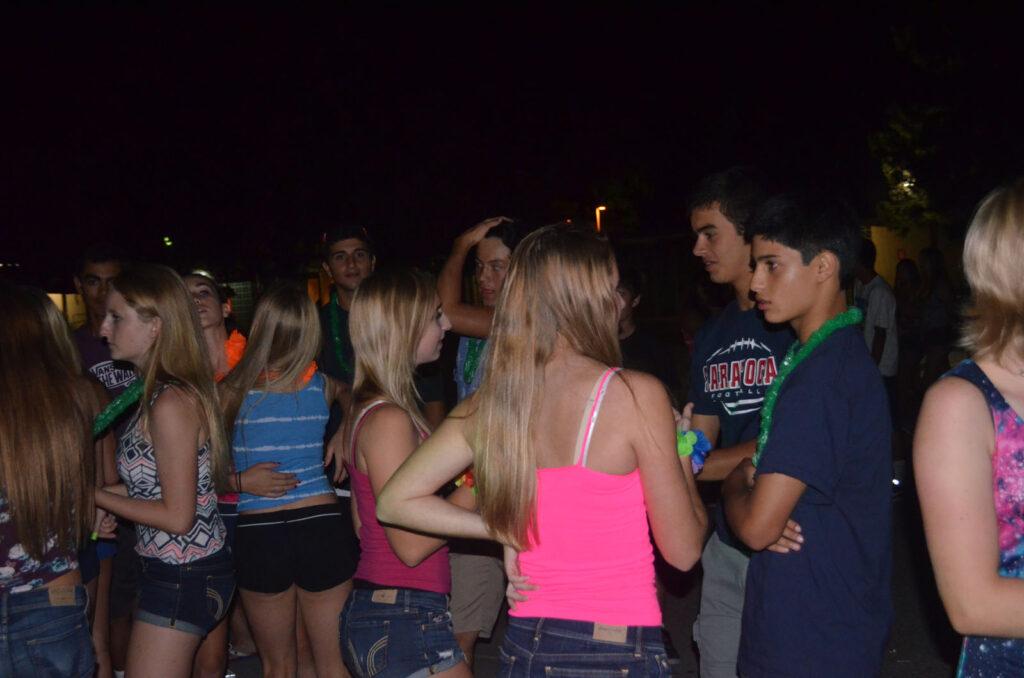More than 150 students danced the night away at the school's Luau-themed kick-off dance in the quad on Aug. 23. This year, the administration enacted a new “face-to-face” dance policy, resulting in an increase in freshman attendance but also a decrease in upperclassman attendance.
Assistant principal Kevin Mount explained this year’s “face-to-face” dancing policy: “The policy now is there’s no freaking allowed at all. We want kids to dance face-to-face, and we feel like that’s appropriate for a school function.”
Many students were caught off guard by what seemed to be a sudden change in the school’s dance policy.
“No one really knows what to do then because all they did was freak,” freshman Sylvia Lee said.
However, administrators said that they have been discussing the “freaking,” a popular style of dance where girls bend over into a boy’s crotch and gyrate in a side-to-side or circular movement, issue for some time now.
In addition, principal Paul Robinson said the administration had first instituted this policy at Senior Prom last spring where they asked students to dance face-to-face.
“I know it appears sudden, but we’ve been discussing it for a couple of years,” Mount said. “I think what really finally got to us was conversations we’ve been having the last couple years with a variety of students, who really just don’t feel comfortable coming to dances.”
The administration went to history classrooms to inform students about the newly implemented policy during the first week of school.
“We went out into all the classrooms over the last couple of days and let kids know that this is where we stand and we have some rules around how you can dance,” Robinson said. “If we find that we need a written policy, then we’ll cross that bridge when we get there.”
Mount also believes that the school’s dance culture must change in order to maintain a safe and positive environment.
“I think we just finally realized that we’ve crossed a line where the dancing was so close and so sexualized that we just said ‘it’s not working for us,” Mount said.
Though there is some disagreement on the “face-to-face” dance policy, especially from the upperclassmen, the purpose of this new policy is to provide students with a fun, safe environment.
“A lot of girls were talking about how, especially younger freshman girls coming in, some of their first dance experiences were just very uncomfortable for them to [freak],” Robinson said.
Despite some opposition to the policy, the administration received positive feedback from parents and students who attended the dance. Yet, several issues came up as a result of this new policy.
One issue that arose in response to the new policy was the possibility of decreased attendance: Many students argued that because this dance was so awkward, the attendance will further decrease at future dance.
The first dances of each school year usually receive an attendance of around 350 to 450 students, but this year’s kickoff dance had a mere 150 attendants.
Nevertheless, parent chaperone Sunder Raj believes that the attendance is will eventually increase.
“I think it’s going to bring out a lot more kids,” Raj said. “Maybe not now, but I think once they get used to it. As these dances go by, I think you’re going to see a lot more participation.”
But whether or not this new policy potentially affects attendance, the administrators said they will remain firm in their decision.
“If dances become something [students] don’t want to participate in, we don’t have to have dances,” Mount said. “I think as adults, as parents, as educators, we just feel like it’s just not appropriate for a school function.”
Mount said some parents have complained about the dancing styles for years. Other parents see the issue as only the typical tension that exists between adults and teens over self-expression.
Another criticism of the policy was its effectiveness.
At the first dance, students formed tight groups, in the middle of which people were “freaking,” some students said.
Sophomore Ruby MacRae feels that cracking down on the dance culture isn’t something the administration should be focusing on.
“The new face-to-face policy is a really immature and stupid way of trying to enforce us not to act in a sexual fashion,” MacRae said. “We are going to find a way to do it anyway, no matter whether it’s in school or not … And that’s not what they should be focusing their attention on.”
Some students believe that the policy will eventually die.
“It was fun as a one time thing, but I still didn’t like the rules,” senior Sahiba Ratra said. “I feel like [the administration] is going to try to make [the new face-to-face policy] stay, but there was such a low attendance, which I think will keep decreasing, that [the administration] will have to remove [the policy].”
Other students found a loophole to the face-to-face dancing policy: They “freaked” face to face. A number of students blamed the DJ for this situation.
“[The songs] are all freaking music. I don’t get it, it’s freaking music,” freshman Sylvia Lee said.
“It’s really awkward: everyone’s just kind of standing around,” freshman Amy Chiang said. “If they didn’t want us to freak, then don’t play freaking music.”
Robinson warned that if a breach of policy comes to his attention, it will not go unpunished.
“We’re going to give them a warning, and if they continue to do it, ultimately we’ll just stop having dances,” Robinson said.
Despite the controversy on the school’s new dance policy, senior Bronwen Bowen believes it’s not the actual banning of “freaking” that is the issue at hand.
“The reason a lot of people don’t like the dance rule is not because they like freaking, and they’re mad at about not being able to freak. I think it’s because [students] are upset at being told what to do outside of classrooms,” Bowen said.


























